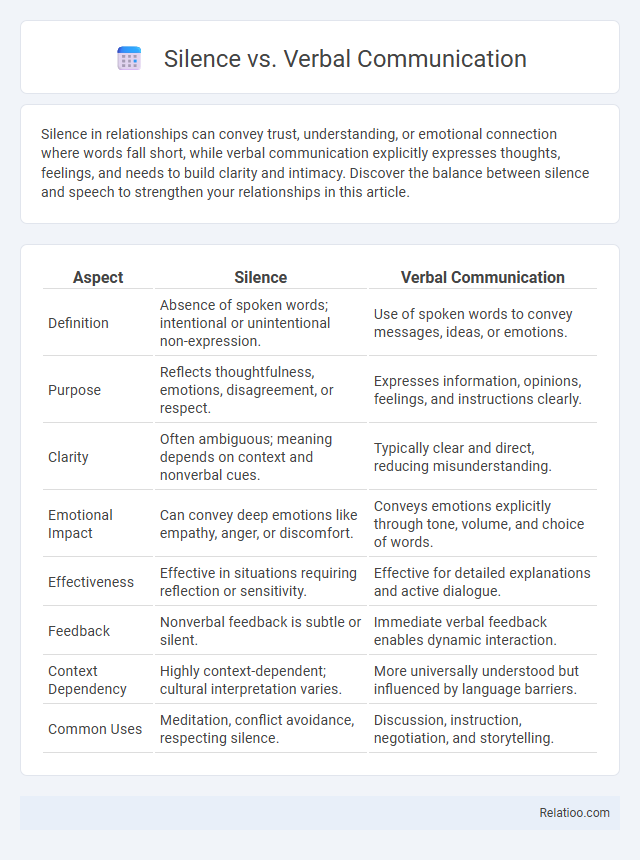Silence in relationships can convey trust, understanding, or emotional connection where words fall short, while verbal communication explicitly expresses thoughts, feelings, and needs to build clarity and intimacy. Discover the balance between silence and speech to strengthen your relationships in this article.
Table of Comparison
| Aspect | Silence | Verbal Communication |
|---|---|---|
| Definition | Absence of spoken words; intentional or unintentional non-expression. | Use of spoken words to convey messages, ideas, or emotions. |
| Purpose | Reflects thoughtfulness, emotions, disagreement, or respect. | Expresses information, opinions, feelings, and instructions clearly. |
| Clarity | Often ambiguous; meaning depends on context and nonverbal cues. | Typically clear and direct, reducing misunderstanding. |
| Emotional Impact | Can convey deep emotions like empathy, anger, or discomfort. | Conveys emotions explicitly through tone, volume, and choice of words. |
| Effectiveness | Effective in situations requiring reflection or sensitivity. | Effective for detailed explanations and active dialogue. |
| Feedback | Nonverbal feedback is subtle or silent. | Immediate verbal feedback enables dynamic interaction. |
| Context Dependency | Highly context-dependent; cultural interpretation varies. | More universally understood but influenced by language barriers. |
| Common Uses | Meditation, conflict avoidance, respecting silence. | Discussion, instruction, negotiation, and storytelling. |
Understanding Silence and Verbal Communication
Understanding silence is crucial in enhancing your communication skills, as it often conveys emotions and intentions beyond words. Verbal communication relies on spoken language and tone to express ideas clearly, while silence can create space for reflection, emphasize points, or signal discomfort. Recognizing the balance between silence and speech enables more effective interactions and deeper comprehension in conversations.
The Psychology Behind Silence
Silence plays a crucial role in communication by conveying emotions and thoughts that words often fail to express, impacting interpersonal understanding and emotional regulation. The psychology behind silence reveals that it can signal contemplation, discomfort, or agreement, influencing how your message is perceived and how you interpret others' intentions. Understanding the nuanced balance between silence and verbal communication enhances your ability to connect deeply and respond empathetically in social interactions.
The Power of Words: Verbal Communication Explained
Verbal communication wields the power to convey emotions, intentions, and clarity with precision, shaping perceptions and building relationships effectively. Your choice of words directly influences understanding and can inspire, motivate, or persuade those around you. Mastering verbal communication enhances your ability to express complex ideas and navigate social interactions confidently.
Nonverbal Cues: The Language of Silence
Nonverbal cues convey powerful messages through silence, often expressing emotions and intentions more effectively than words. Your body language, facial expressions, and pauses in conversation serve as a silent language that influences interpersonal connections and understanding. Mastering the language of silence enhances communication by allowing you to interpret unspoken signals and respond with empathy.
Cultural Perspectives on Silence and Speech
Cultural perspectives on silence and speech vary widely, influencing communication styles across societies. In many East Asian cultures, silence is valued as a sign of respect, thoughtfulness, and harmony, contrasting with Western cultures where verbal communication is often prioritized for clarity and assertiveness. Understanding these cultural nuances is critical for effective cross-cultural interactions and reducing misinterpretations in global communication contexts.
Benefits of Embracing Silence in Communication
Embracing silence in communication enhances active listening, allowing you to fully absorb and understand the speaker's message without interruption. Silence fosters thoughtful reflection, leading to more meaningful and intentional responses that strengthen relationships. By valuing pauses and quiet moments, your interactions become more balanced, reducing misunderstandings and promoting emotional intelligence.
When Words Matter More: The Importance of Verbal Expression
Verbal communication plays a crucial role when clarity, emotional expression, and immediate feedback are essential, especially in complex discussions or conflict resolution. You convey intentions, feelings, and detailed information more effectively through speech, reducing misunderstandings that silence might create. Mastering when to speak ensures your message is heard and your relationships remain strong and transparent.
Common Misinterpretations of Silence
Silence is often misinterpreted as agreement, disinterest, or avoidance in communication, leading to misunderstandings and stalled conversations. Verbal communication provides explicit clarity, yet silence can convey powerful unspoken emotions or intentions that are frequently overlooked. Recognizing cultural and contextual factors is essential to accurately interpret the meaning behind silence and reduce common misinterpretations.
Balancing Silence and Speech for Effective Communication
Balancing silence and speech is essential for effective communication, as strategic pauses allow you to absorb information and convey thoughtfulness while spoken words express clarity and intention. Silence can emphasize key points, create space for reflection, and reduce misunderstandings, whereas verbal communication provides context, emotion, and direct interaction. Mastering this balance enhances your ability to listen actively and respond thoughtfully, fostering deeper connections and mutual understanding.
Strategies to Enhance Both Silent and Verbal Interactions
Effective communication strategies balance silence and verbal interaction by emphasizing active listening, allowing pauses for reflection, and using nonverbal cues to reinforce messages. Incorporating mindful silence fosters deeper understanding and emotional connection, while clear verbal articulation ensures information clarity and engagement. Training in both silence utilization and verbal expression improves interpersonal dynamics and conflict resolution outcomes.

Infographic: Silence vs Verbal Communication
 relatioo.com
relatioo.com